I’ve had a bit of interest over the last few weeks regarding quail as a backyard meat source. I thought I’d dust off the topic and put another article together covering the ins and outs of raising Coturnix quail, particularly in an urban setting. It is a rather long article, but still not as detailed as I’d like. I may expand on the topic in an eBook… And finally, this is dedicated to Mr. Mike in Rio and Justin in Alabama.
Chickens are the go-to for the homesteader when you initially think of adding in livestock. And while there are many other options for the rural homesteader that work just as well as (and sometimes even better than) chickens (like goats, pigs, Muscovy ducks or Guinea fowl), trying to raise your own animal protein in an urban environment starts to limit your options.
Due to their size, pigs, cows, and goats are out of the question. You need something small, quiet and still a good producer.
Rabbits fit the bill, and while I raise them for meat myself, there is a stigma regarding rabbits as food in this country.
Guinea pigs also fit the bill, and there is a growing “guinea pigs for meat” movement here in the United States, believe it or not. However, Guinea pigs have an even worse aversion in this country.
Fish are also a possibility, but come with their own problems and pitfalls.
Meal worms are a possibility, I suppose, but try getting the brother-in-law over for dinner. (Wait, I see a selling point…)
The only other reasonable option I can think of is some sort of bird.
I have found that if you are looking for a self-sustaining population of birds for both eggs and meat, yet are limited due to zoning (no “livestock”), noise (no roosters), space (no free range), or simply wanting to fly under the local radar (pun intended) for OPSEC reasons, then you may want to look into raising Coturnix quail.
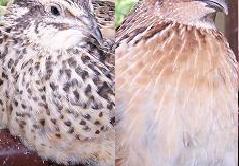
Their Latin name is Coturnix japonica, but they have various common names, “Coturnix quail”, “Pharaoh quail”, “Jumbo Brown“, and “Japanese quail“. Their natural color is a mottled brown, but their are roughly a dozen color mutations recognized. The other recognized color variants that I am aware of are Texas A&M, Manchurian, Tibetan, English White, Golden Range, Red Range, Italian, Rosetta, Scarlett, Golden Tuxedo, and Roux Dilute. Much like guppies, with a little selective breeding, and the time, you could easily develop your own color scheme in a year or two.
I prefer to stick with the browns for ease of determining sex, since they are sexually dimorphic. At around three weeks, as they start to feather out fully, you’ll notice the males have a rust-covered upper breast. The females are simple mottled black or brown and cream.
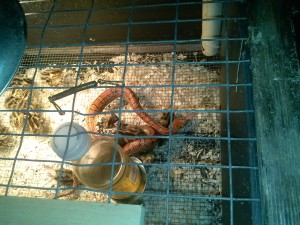
This is bad.
Coturnix quail are much smaller than chickens, weighing in around 12 -16 ounces live weight, with males usually smaller than females. They do well in cold or warm climates, as long as they have protection from direct sun for hot climates, and protection from drafts for colder areas. They have been domesticated for centuries, with records of them in captivity as far back as the 11th century in Japan (thus one of their names). Since they have been domesticated for so long, protection from predation is a must. While they are cute, the are rather dumb, with virtually no survival instincts. Everything finds them tasty. I’ve had my share of issues with predators over the years, as the picture here shows.
Why Quail?
What draws me to them is the production numbers they can achieve vs the amount of inputs needed when compared to the baseline of all homesteaders, the chicken:
| Coturnix Quail | Chickens |
| Incubation: 17-18 days |
Incubation: 21 days |
| From hatch to harvest weight: 7-8 weeks |
From hatch to harvest weight: 6-7 weeks in commercially-raised Cornish X, 9-20 weeks on most other breeds. |
| From hatch to egg laying: 5-6 weeks, with some reports of eggs as early as 4 1/2 weeks. |
From hatch to egg laying: 16-24 weeks. |
| Feed to egg conversion: 2 pounds of feed to produce a pound of eggs, 300+ eggs per year |
Feed to egg conversion: Chickens require 3 pounds of feed to produce a pound of eggs, 180-300 eggs per year |
| Space requirements per bird: Quail need 16-25 square INCHES, though many people say 1 square foot. I house up to 20 birds in a 2×3 foot wire cage with no apparent ill affects. |
Space requirements per bird: Chickens need 3-4 square feet inside, plus a run or free ranging, or 10 sq. ft. if coop kept. |
Simply put, Quail produce more in less time and less space, with fewer inputs than chickens.
To compare it another way, look at these packages of seeds for time to harvest from planting date:

For Coturnix quail, you have 17 days in the incubator, 21 days to feather out, and then another 21 days to reach full size. 17+21+21=59 days to harvest.
Peas, beans, and tomatoes take 70 or more days to harvest!
Quail go from an egg placed in an incubator to a full grown bird in 59 days. And if it is a female, you’ll get as many as a dozen eggs from the bird before it reaches harvest size in that same 59 days. Craziness.
And if you plant the same listed veggies on the same day that you put the Coturnix eggs into the incubator, you’ll have to wait more than a week after your quail harvest for your peas, beans and tomatoes to be ready.
Hatching
The one downfall I’ve found with them is the fact that like most production birds, quail have poor mothering skills, and rarely go broody. This means a surrogate is needed to hatch the eggs. I have used both a frizzle bantam hen and a home-built incubator, and have had great success with both. (Watching the minuture hen running around with even smaller baby quail was hilarious.) Since I no longer have the chickens, I now rely solely on my incubator.
As I mentioned above, once hatched, they need to be kept in a brooder until feathered out, roughly 3 1/2 to 4 weeks. Here in Florida, I normally move them at 21 days. A brooder is simply a ventilated, but draft-free container with a heat source, a constant supply of clean water, and a never-ending supply of quality feed. I prefer one with a screened bottom to allow much of the waste to be easily removed. My design has coroplast sides, a 1/2 by 1/2 screen mesh for the bottom, and a screened top. For my next batch, I will be replacing the screening on top for something with a smaller opening in the mess to prevent the picture above from happening again.
Grow Out
Once feathered, they require a little more space. I move mine to a grow out pen that still offers shelter from breezes and wet weather. This is basically just another one of my converted rabbit cages. They stay here until harvest size, where I graduate the extra males to “Freezer Camp”. The lucky males and the females all get moved to a larger pen set up for egg production.
For fertilized eggs, I like a ratio of 1 male to every 4-6 females. This works for me, though I’ve seen ranges of 1:3 up to 1:10 suggested.
Eggs
The health comparison of quail eggs vs chicken eggs:
- contain 13 percent protein, versus 11 percent in chicken eggs,
- almost three times of the vitamin B1 found in chicken eggs,
- twice as much vitamin A and B2,
- provide five times as much iron and potassium,
- have not been shown to cause all of the same allergies as chicken eggs, and may help to fight allergy symptoms due to the type protein they contain.***(See comments below!!!)
- twice as much vitamin A and B2.
- and richer in phosphorus and calcium than a chicken egg.
Quail eggs are simply a healthier option versus chicken eggs.
If you are raising Coturnix quail for eggs, I suggest a sloped bottom cage with a small gap at the bottom of the front and a catch tray, to allow the eggs to roll though and make collecting them easier. It keeps the eggs cleaner, and makes for easier egg collection. This is the setup I use, and its worked very well for me, saving me time, and eliminating the need to stick my arm into the birds’ cage and disrupt their lives.
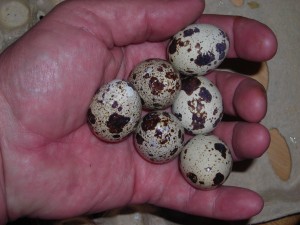
The quail eggs themselves taste, well, like eggs. Since they are smaller, any recipe calling for a chicken egg will require 3-5 quail eggs to substitute per chicken egg.
The only other difference we’ve found from years of consuming them is that the membranes of the quail egg is MUCH tougher than any chicken egg I”ve ever cracked open. This membrane is located just beneath the shell to provide a layer of defense against bacterial invasion, and is so tough that cracking the egg like you would a chicken egg just works poorly. The shell is held together no matter how much you try to crack the small eggs. After 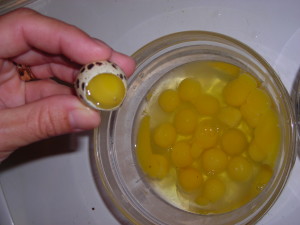 several frustrating weeks while we were starting to incorporate quail eggs into our diet, we found a handy device to open them, a trick used at sushi bars – a quail egg cutter.
several frustrating weeks while we were starting to incorporate quail eggs into our diet, we found a handy device to open them, a trick used at sushi bars – a quail egg cutter.
A cross between a pair of scissors and a cigar cutter, it simply shears off the very top of the egg, allowing you to pour out the contents.
See it here in action as we prepare to make an omelet:
If you decide to start to consume them daily like we do, you’ll be opening a bunch of quail eggs. And since it takes multiple quail eggs to equate to a chicken egg, it is worth owning one of these .
Meat
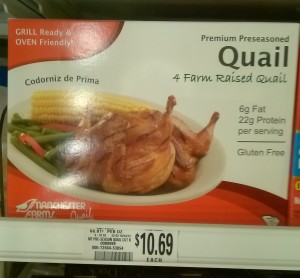
If you prefer to raise them for meat, quail are easy to harvest, one of the easiest birds I’ve had to clean. The meat is flavorful, and like everything, tastes similar to chicken. If you are raising them only for meat, or if you have excess males, it is fine to simply keep them in the brooder, gradually decreasing the heat each week until they are feathered out, then simply harvest them at 7-8 weeks. No need to have a cage for them to inhabit, simplifying your setup.
Silence is Golden
In raising them in an urban setting, another benefit if trying to maintain a low profile is the fact that they are mostly silent. While the mature males will “crow”, it is nowhere near as disruptive as a male chicken crowing. If you limit the number of males, or keep them out of sight of other pens of quails, I’ve found they rarely have to announce their presence. It seems to be done to try to outdo the other males. The hens will occasionally chirp or purr, but from my experience, it cannot be heard more than a few yards away. And when it is, nobody notices yet another “songbird” in the area.
Housing
I prefer wife cages, using the same cage setup that I use for my rabbits. Bottom wire is made from 1 inch by 1/2 inch welded wire to allow dropping to fall through. The only modification I make to rabbit cages is to lower the ceiling to 8 inches to prevent fatalities from birds launching themselves into the ceiling. My typical rabbit cage can house as many as 24 quail with no crowding issues. I also use hanging cages, and like to have a slight incline for the quail cage to allow the eggs to roll to the front of the cage. This makes collecting the eggs much easier.
I have tried several different methods to gets the eggs out of the cage automatically. My favorite method is to have a one inch section at the bottom of the cage to be hinged at the top. With the incline and the weight of the eggs, they simply roll through the hanging “door” into a tray placed right below the opening.
Searching the internet, you can find folks raising Coturnix quail in converted aquariums, Rubbermaid totes, or even large cardboard boxes – ALL INSIDE A HOUSE! Coturnix quail are rather adaptable to growing in a large variety of controlled environments.
Feed
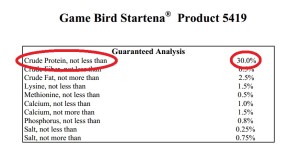
The ULTIMATE SECRET to raising quail is this : high protein feed. Protein content of 30% or higher allows for fat growth, and higher egg production. I opt for Gamebird Feed whenever I can, and prefer the 30% or higher, when I can find it. In a pinch, I can get by with 20% protein, but the egg production and speed of growth DOES suffer for it. Do NOT skimp on feed!
Quail Sources
You have three options for getting started – adult birds, hatchlings, or fertile eggs to hatch yourself. Both adult Coturnix quail and hatchlings need to be sourced locally, they just don’t ship well, and therefore most sources won’t bother shipping live Coturnix quail.
Craigslist is a good place to start to try to find local options for all three starter options. In addition, many online sources can be found for “hatching eggs”, or fertile eggs recently laid, and ready to be incubated.
Just be sure that it is a smaller framed chicken, the quail hatchlings are small enough to fit a couple of them into a shot glass! I had a silky bantam once that was almost perfect as a surrogate mother. She was only ounces larger than the largest quail I had, and she simply lived to hatch eggs, staying broody far more than not.
Personally, I started with 30 hatching eggs, mailed to me via Priority Mail, from Wisconsin. The eggs arrived in a couple days, I popped them into my homemade incubator for 17 days, and roughly three weeks from the day I ordered the eggs, I had 90% of the eggs hatch out! These 27 birds grew into a flock I maintained for almost two years, providing about a dozen eggs a day.
Since breeding rations are suggested at 1 male for every 3-5 females for optimal egg fertilization, I harvested the smaller males around 8 weeks, and keeping the largest three to service my 14 hens. I would periodically set additional batches of eggs to hatch, replacing hens as I harvested them. I would still have the original line of birds if I hadn’t decided to slow down for various reasons. When perpetuating your own line like this, its a good idea to introduce bloodlines from new stock from time to time to prevent too much inbreeding.
I have since reestablished my flock, starting with only eight birds, knowing that I can easily get up to dozens of birds in a matter of months.
Possibly the Best Urban Option?
Since they offer a quick turnaround for both eggs and meat, take up little space, and do very little to draw attention to themselves, Coturnix quail may be the best option for an urban homesteader, and a no-brainer for anyone wanting to add an initial source of protein, or just add some variety without taking up a lot of space and/or time.
Peace,
db
As always, please “like” FloridaHillbilly on Facebook, subscribe to my feed, follow me on Twitter, add it to Google+, Pinterest, Linkdn, Digg, and/or tell your friends! The more folks that start behaving like ants, the fewer grasshoppers there will be left needing help.
Need something from Amazon (and who doesn’t)? I earn a small commission from purchases made when you begin your Amazon shopping experience here. You still get great Amazon service and your price is the same, no matter what. And for the record, all of my Amazon links provide me with this referral fee.
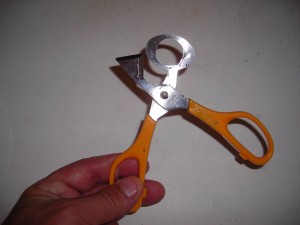
Great article on a subject that I am passionate about. I hadn’t seen the quail egg cutter and will have to look into getting one.
One point I would like to expand on is local ordinances. Many communities have rules regarding keeping livestock in the city and more and more have chicken specific guidelines. The reason I originally got into raising quail was because my city had rules regarding everything else (chicken, rabbits, goats, geese, cows, pigs, horses, etc) but NOTHING about quail. So I figured if someone raised a fuse I would say just show me the city code where it is prohibited.
Keep the great information coming!
You are correct on this. However, there are some municipalities that simply state “livestock”, or “fowl”.
Depending on your lawyers ability, I’d leave that defense up to the courts – quail are not considered livestock, they are considered game birds With that being said, my resident state of Florida has regs regarding raising quail. My interpretation is that you can have up to 50 birds without requiring a permit.
With that being said, my resident state of Florida has regs regarding raising quail. My interpretation is that you can have up to 50 birds without requiring a permit.
And as always, thanks for stopping by, Perry! And folks, hit his site if you want mroe info regarding backyard quail!
Correct, my state only regulates Bob White so nothing specific to Coturnix quail.
Thanks db. Awesome article. I’m constantly telling people about the quail – chicken comparison you taught me. Now I also get to ask people if they know what ‘sexually dimorphic’ is.
You talk like a lawyer…
Great article db. Very informative. I’m seriously thinking about raising some quail.
You should…easy and efficient!
Just wondering – where did the information about quail eggs being safe for those with egg allergies come from? I’d love to see the study.
I had heard that if you are allergic to chicken eggs, you are likely allergic to all eggs, and that there are cases of being allergic to one kind of egg but not another, but they are very rare.
I’m not allergic to eggs, but I am sensitive to them – they give me terrible gut ache. I guess the only way to find out if quail eggs would do the same thing is to try them! (I miss eggs terribly – it would be awesome if quail were the answer!)
In going back through my resources, and cross checking the information with multiple sources, I’m finding that the answer to this question may end up as long as the article above!
The short answer is from various user forums for homesteading and backyard poultry. Many folks have posted great success in using quail eggs when they were “allergic” to chicken eggs.
The better answer would be that no matter what others have found, each person should take food allergy alternatives on a personal basis – each allergic person may have different issues from one person to the next. In double-checking my sources, and cross checking their validity and particular situation, I’m am going to modify my article above to point to this comment and add:
Quail eggs MAY be a valid replacement for those with egg allergies, depending on what particular part of the egg is the trigger. Quail eggs and chicken eggs have many proteins in common, and should one of them be the trigger agent, quail eggs will also trigger the allergic reaction. However, if the trigger agent is only in chicken eggs and not in quail eggs , then quail eggs MAY be a valid alternative.
If you are sensitive to chicken eggs, I’d say give them a try.
Having gone to a rather strict Paleolithic diet myself, there are many things I no longer eat (but would LOVE to) due to affecting my health, so I do understand your situation. Biscuits and gravy are at the top of that list…and I just perfected my recipe for both too! I can make a biscuit from scratch that my grandfather would be proud to serve, and he was a fantastic cook, with years of cooking. There are some days that I just bite the bullet and fall off the wagon….and suffer the consequences. Many times, health is just a choice.
Choose wisely
I grew up hunting and eating quail but now that the farmers have bulldozed all the hedgerows out there aren’t enough left that I feel comfortable hunting them. Sure miss eating quail and I think I’ll give raising them a try after reading your article.
Thanks for the encouragement!
AJ
These are far easier to catch
I’d be interested in hearing what greens are favoured by the quail.fruit tree leaves?dandelion,chickweed,mares tail,grass,plantain?These my chickens seem to like best,and is what I have.
My quail have been fed straight mill-processed feed, normally something by Purina. I’ve never offered than anything else, other than the occasional pan of sand to frolic and give themselves a dust bath.
I should look into that with my next batch…it would cut down feed costs, use up an available and unused resource, and probably provide a more well-rounded diet.
I am an urban homesteader on a tiny little city lot and will be adding quail as soon as I can work out the housing. I am a terrible builder, but I am going to give it a try.
We have several meat rabbits, will be excited to get some faster turn around on the time we put into the live food around here!
I use old rabbit cages for my quail
Hi there!
I’ve touched base with you via facebook but thought this source of communication might benefit others. I live very near you. We hatched out 12 coturnix last week.
I’m interested to hear how they fair in Florida weather year round…
Do you ever have to cover them or bring them indoors during our 1-day cold snaps?
Do you use a fan on them during the summer when it gets brutally hot with high humidity?
How do they do during our daily summertime thunderstorms? I understand that they startle easily. I’m hoping to use our chicken coop that has a raised enclosed nesting area. Will they use it to get out of the elements? Does this suffice for comfort during those lightning-flashing storms that come daily?
Anything else different in our climate than what I’m reading on all the websites that usually refer to northern climates?
Thanks for your help!
I could (and probably SHOULD!) write a book on raising quail.
Coturnix quail fair very well here. I am in Martin County FL, about a mile west of the Atlantic ocean, on the Atlantic Ridge, roughly 30 feet above sea level. We are Ag zone 10a, and almost never get frost.
My Coturnix quail are kept in a all wire cage, with 1 inch by 1/2 inch wire mesh for the bottom, and 1×1 or 1×2 in mesh for the sides. Top to bottom measurements are between 8 and 12 inches. This is to prevent the quail from gaining enough velocity when spooked to smash open their skulls when the launch straight up from fear. Alternatively, some sort of cloth could be placed inside the top to cushion the blow, because they WILL launch.
The cages are suspended from a corrugated metal roof located under a large mango tree. The tree provide LOTS of shade, thus the cages have two layers of sun protection, and ample air circulation between the cage and the roof. In the hot months, I also have a hot water heater thermostat that kicks on a 12v truck radiator fan powered by deep cycle batteries. The batteries are charged via solar panels. Once established, I have had to do very little to keep everything up and running. Incidentally, the quail are housed in the same fenced in area that holds my rabbit cages. Both animal types are housed in similar ways, with the cage height being the biggest difference.
Another heat deterrent is a dust bath. Want to see something hilarious? Keep the quail in a wire-floored cage, and after they reach maturity, put a kitty litter pan in full of sand. It is the Coturnix quail version of Black Friday, with the dust bath being a $5 Dooney & Bourke purse.
“Cold” winters here are 50 and lower On the days in the 30s (!!) or 40s, I usually take a empty feed sack and hang it over the sides of the quail cages to slow down the wind. The cold isn’t bad if the birds can get out of the wind. I also put the same kitty litter pan (mentioned above) to give them more of a wind break. on the worst days, I’ve seen them huddled together, each jockeying for a spot in the middle of the pile.
On the days in the 30s (!!) or 40s, I usually take a empty feed sack and hang it over the sides of the quail cages to slow down the wind. The cold isn’t bad if the birds can get out of the wind. I also put the same kitty litter pan (mentioned above) to give them more of a wind break. on the worst days, I’ve seen them huddled together, each jockeying for a spot in the middle of the pile.
I’ve found that any type of nesting is all but useless. Quail will be walking around, get the urge to push, and drop an egg. Without even looking back, it moves on again, oblivious to the egg. (What do you expect from a domesticated bird with the brain the size of a pea?) This makes gathering eggs a bit of a pain when you keep them in a large enclosure.
The only thing I should stress, provide PLENTY of water. Unlimited amounts, if possible. I use an automatic waterer hooked into my water system.
Hope all that helps!
Peace,
db
I appreciate you sharing your “tricks-of-the-trade” that I’m sure you acquired through trial and error. I’m sure we will experience our own trial and errors but you’ve helped eliminate quite a few.
Thank you,
Angela
Great article but I particularly liked the typo “I prefer wife cages,” at the start of the Housing section. :o)
Who said that was a typo?